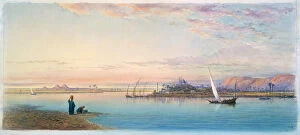Pilleau Collection
"Pilleau: Capturing the Essence of Egypt Through Art" Step into the mesmerizing world of Arthur William Pilleau
All Professionally Made to Order for Quick Shipping
"Pilleau: Capturing the Essence of Egypt Through Art" Step into the mesmerizing world of Arthur William Pilleau, an artist whose brushstrokes transported viewers to the enchanting landscapes of Egypt. Born in 1813, this English artist left an indelible mark on art history with his stunning depictions of Egyptian villages and ancient temples. One cannot help but be captivated by Pilleau's masterpiece, "Egyptian Village" painted in 1869. With meticulous attention to detail, he brings life to every corner of the canvas, immersing us in the vibrant culture and daily lives of its inhabitants. In "Interior of the Great Hall of Karnac, " created in 1845, Pilleau takes us on a journey through time as we explore one of Egypt's most iconic landmarks. The grandeur and majesty captured within this piece leave us awestruck at both Pilleau's talent and the magnificence of ancient Egyptian architecture. "The Nile by Bulaq" transports us to the tranquil banks of this legendary river. Painted in 1868, Pilleau skillfully captures its serene beauty while infusing it with a sense of mystery that has fascinated explorers for centuries. Edfou becomes alive under Pilleau's brush as he presents it to us through a lithograph from the 19th century. The intricate details showcase his ability to capture not only architectural wonders but also evoke emotions tied to these historical sites. Medinet Abou comes alive before our eyes as we gaze upon another lithograph by Henry Pilleau from the same era. His mastery lies not only in replicating what he sees but also conveying a sense of wonder that echoes throughout each stroke. The Temple at Denderah stands tall and proud under Pilleau's artistic vision during Egypt's golden age. This masterpiece showcases his ability to transport viewers back in time while preserving the beauty and grandeur of these ancient structures.













